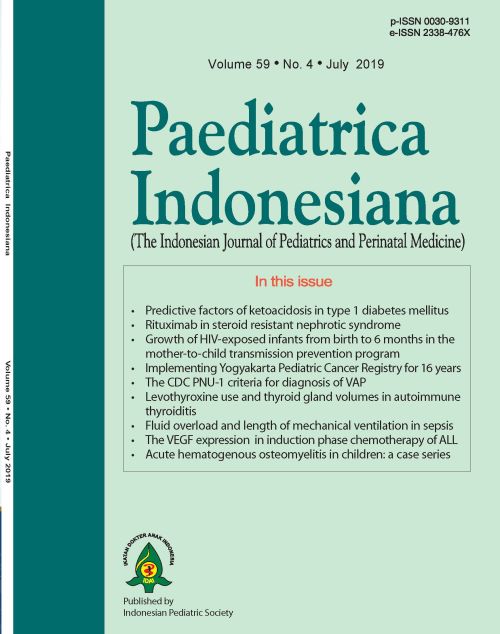Growth of HIV-exposed infants from birth to 6 months in the prevention of mother-to-child transmission program
Abstract
Background Human immunodeficiency virus (HIV) infection is a global health issue. Most cases of HIV infection in children are acquired through transmission from HIV-infected mothers. Maternal HIV infection affects infant growth.
Objective To evaluate the first six months of growth in HIV-exposed infants born to mothers in the prevention of mother-to-child transmission (PMTCT) program.
Methods This prospective cohort study was done in 40 HIV-exposed infants born in Sanglah General Hospital, Bali. Subjects' underwent weight and length measurements at birth and monthly for 6 months. Data analyses used were repeated ANOVA test with Bonferonni post-hoc analysis for normally distributed data and Friedman test with Wilcoxon post-hoc analysis for abnormally distributed data. Correlations between birth weight and length to weight and length at 6 months of age were analyzed with Spearman's test.
Results Subjects' mean birth weight was 2,900 (SD 546) grams and median birth length was 48 (range 36-52) cm. Subjects' body weight and length increased monthly throughout the measurement period (P<0.001). There was a strong negative correlation between birth weight and infant weight gain at 6 months of age (r=-0.678), and a moderate negative correlation between birth length and infant length gain at 6 months of age (r=-0.564).
Conclusion HIV-exposed infants born to mothers in the PMTCT program have a significant body weight and body length growth in the first 6 months of life, and followed general WHO weight and length curves for age.
References
2. Sohn AH, Hazra R. The changing epidemiology of the global paediatric HIV epidemic: keeping track of perinatally HIV-infected adolescents. J Int AIDS Soc. 2013;16:18555.
3. Kementerian Kesehatan RI. Profil kesehatan Indonesia tahun 2012. Jakarta: Kemenkes RI; 2012.
4. Gaur AH, Dominguez KL, Kalish ML, Rivera-Hernandez D, Donohoe M, Brooks JT, et al. Practice of feeding premasticated food to infants: a potential risk factor for HIV transmission. Pediatrics. 2009;124:658–66.
5. Evans C, Jones CE, Prendergast AJ. HIV-exposed, uninfected infants: new global challenges in the era of paediatric HIV elimination. Lancet Infect Dis. 2016;16:e92-e107.
6. Siberry GK, Williams PL, Mendez H, Seage GR 3rd, Jacobson DL, Hazra R, et al. Safety of tenofovir use during pregnancy: early growth outcomes in HIV-exposed uninfected infants. AIDS. 2012;26:1151–9.
7. Neri D, Somarriba GA, Schaefer NN, Chaparro AI, Scott GB, Lopez Mitnik GL, et al. Growth and body composition of uninfected children exposed to human immunodeficiency virus: comparison with a contemporary cohort and United States National Standards. J Pediatr. 2013;163:249–54.
8. Xiong X, Wightkin J, Magnus JH, Pridjian G, Acuna JM, Buekens P. Birth weight and infant growth: optimal infant weight gain versus optimal infant weight. Matern Child Health J. 2007;11:57–63.
9. Borah M, Baruah R. Physical growth of low birth weight babies in first six months of life: a longitudinal study in a rural block of Assam. Natl J Community Med. 2014;5;397-400.
10. Westerberg AC, Henriksen C, Ellingvåg A, Veierød MB, Júlíusson PB, Nakstad B, et al. First year growth among very low birth weight infants. Acta Paediatr. 2010;99:556-62.
Copyright (c) 2019 Maria Priskila

This work is licensed under a Creative Commons Attribution-NonCommercial-ShareAlike 4.0 International License.
Authors who publish with this journal agree to the following terms:
Authors retain copyright and grant the journal right of first publication with the work simultaneously licensed under a Creative Commons Attribution License that allows others to share the work with an acknowledgement of the work's authorship and initial publication in this journal.
Authors are able to enter into separate, additional contractual arrangements for the non-exclusive distribution of the journal's published version of the work (e.g., post it to an institutional repository or publish it in a book), with an acknowledgement of its initial publication in this journal.
Accepted 2019-07-24
Published 2019-07-24













